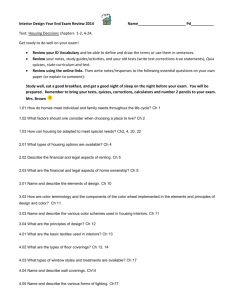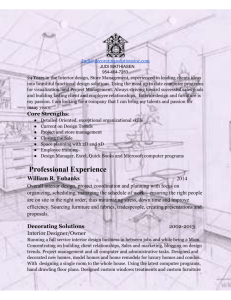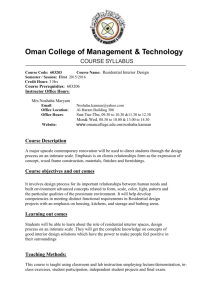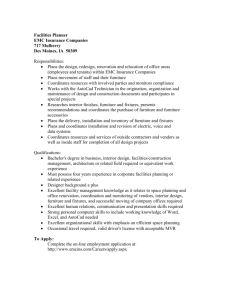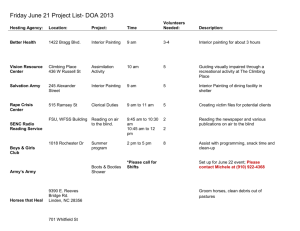Interior Design "f" Visual and Performing Arts A-G Outline
advertisement
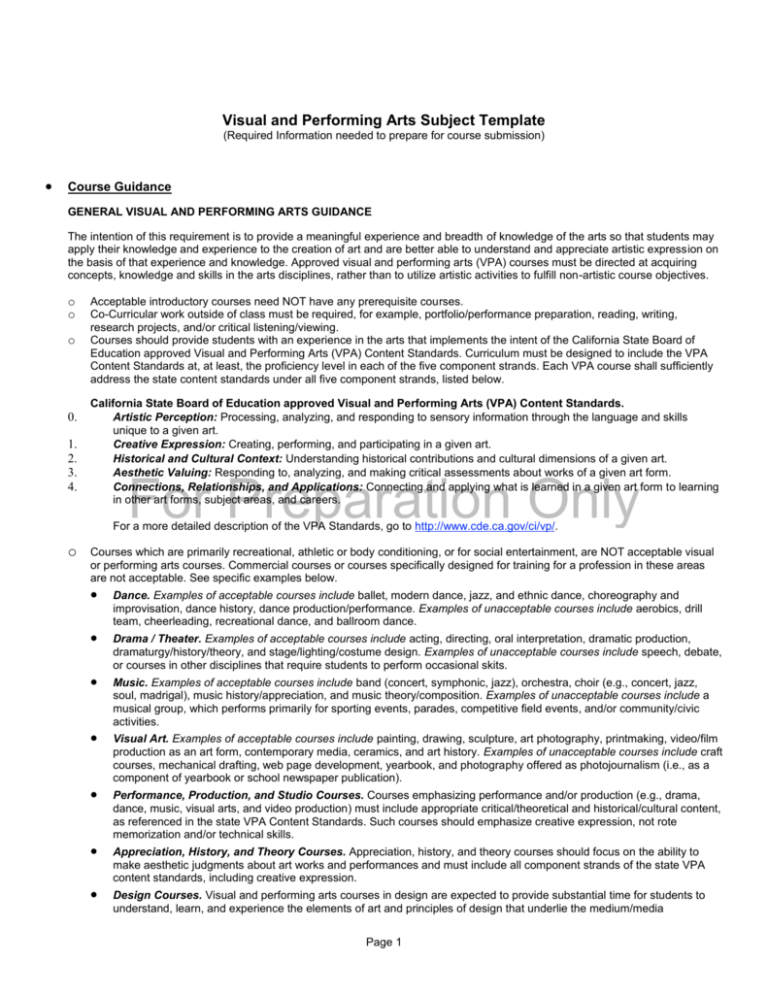
Visual and Performing Arts Subject Template (Required Information needed to prepare for course submission) Course Guidance GENERAL VISUAL AND PERFORMING ARTS GUIDANCE The intention of this requirement is to provide a meaningful experience and breadth of knowledge of the arts so that students may apply their knowledge and experience to the creation of art and are better able to understand and appreciate artistic expression on the basis of that experience and knowledge. Approved visual and performing arts (VPA) courses must be directed at acquiring concepts, knowledge and skills in the arts disciplines, rather than to utilize artistic activities to fulfill non-artistic course objectives. o o o 0. 1. 2. 3. 4. Acceptable introductory courses need NOT have any prerequisite courses. Co-Curricular work outside of class must be required, for example, portfolio/performance preparation, reading, writing, research projects, and/or critical listening/viewing. Courses should provide students with an experience in the arts that implements the intent of the California State Board of Education approved Visual and Performing Arts (VPA) Content Standards. Curriculum must be designed to include the VPA Content Standards at, at least, the proficiency level in each of the five component strands. Each VPA course shall sufficiently address the state content standards under all five component strands, listed below. California State Board of Education approved Visual and Performing Arts (VPA) Content Standards. Artistic Perception: Processing, analyzing, and responding to sensory information through the language and skills unique to a given art. Creative Expression: Creating, performing, and participating in a given art. Historical and Cultural Context: Understanding historical contributions and cultural dimensions of a given art. Aesthetic Valuing: Responding to, analyzing, and making critical assessments about works of a given art form. Connections, Relationships, and Applications: Connecting and applying what is learned in a given art form to learning in other art forms, subject areas, and careers. For Preparation Only For a more detailed description of the VPA Standards, go to http://www.cde.ca.gov/ci/vp/. o Courses which are primarily recreational, athletic or body conditioning, or for social entertainment, are NOT acceptable visual or performing arts courses. Commercial courses or courses specifically designed for training for a profession in these areas are not acceptable. See specific examples below. Dance. Examples of acceptable courses include ballet, modern dance, jazz, and ethnic dance, choreography and improvisation, dance history, dance production/performance. Examples of unacceptable courses include aerobics, drill team, cheerleading, recreational dance, and ballroom dance. Drama / Theater. Examples of acceptable courses include acting, directing, oral interpretation, dramatic production, dramaturgy/history/theory, and stage/lighting/costume design. Examples of unacceptable courses include speech, debate, or courses in other disciplines that require students to perform occasional skits. Music. Examples of acceptable courses include band (concert, symphonic, jazz), orchestra, choir (e.g., concert, jazz, soul, madrigal), music history/appreciation, and music theory/composition. Examples of unacceptable courses include a musical group, which performs primarily for sporting events, parades, competitive field events, and/or community/civic activities. Visual Art. Examples of acceptable courses include painting, drawing, sculpture, art photography, printmaking, video/film production as an art form, contemporary media, ceramics, and art history. Examples of unacceptable courses include craft courses, mechanical drafting, web page development, yearbook, and photography offered as photojournalism (i.e., as a component of yearbook or school newspaper publication). Performance, Production, and Studio Courses. Courses emphasizing performance and/or production (e.g., drama, dance, music, visual arts, and video production) must include appropriate critical/theoretical and historical/cultural content, as referenced in the state VPA Content Standards. Such courses should emphasize creative expression, not rote memorization and/or technical skills. Appreciation, History, and Theory Courses. Appreciation, history, and theory courses should focus on the ability to make aesthetic judgments about art works and performances and must include all component strands of the state VPA content standards, including creative expression. Design Courses. Visual and performing arts courses in design are expected to provide substantial time for students to understand, learn, and experience the elements of art and principles of design that underlie the medium/media Page 1 addressed. Design courses must also include standards from all five component strands of the VPA content standards. (Refer to the Design Course Resources available on the a-g Guide web site.) Technology Courses. Visual and performing arts courses that utilize technology must focus primarily on arts content. If the technology (i.e., software, equipment) is used as a tool of artistic expression, as a paintbrush would be used in a painting course, and all other component strands are adequately met, then such courses are acceptable. If the technology/software is so complex that the primary concern becomes learning the technology, then the course will not be approved to meet the VPA requirement. HONORS VISUAL AND PERFORMING ARTS GUIDANCE o Visual and Performance Arts Honors courses are expected to provide both breadth and depth of exploration in the subject area, developing writing, research, and analytical skills. Specific detailed evidence must be included in the course outline. o The courses must offer content and/or experience that are demonstrably more challenging than what is offered through the regular college preparatory courses in the same field. o Factors considered for UC approved honors courses that satisfy the "f" requirement include but are not limited to the assignment and evaluation of one long or numerous short, challenging, and properly-annotated research papers and a comprehensive final examination. Specific details of each of these assignments are required. o The use of college-level textbooks is encouraged. o Regular college preparatory courses in the subject areas should be offered. If regular non-honors courses are offered, a strong justification for the lack of a regular course is required. o In addition to AP and IB higher level courses, high schools may certify as honors level courses not more than one unit for each Visual & Performing Arts Discipline. o A single, written, comprehensive, full year final exam must be administered that encompasses all the material that has been covered for the entire year. Course Content NOTE: The following questions are subject specific and ask for detailed information regarding the course curriculum. Since UC has developed their own criteria for the review of curricula, it is not necessary (and preferred) that the State Standards are not listed when submitting course descriptions to the University. When preparing the course submission, keep in mind that your audience is the UC High School Articulation unit and UC faculty. Include relevant information that would assist those reviewing the course and provide UC a better understanding and clarity about the intent of the curriculum. UC expects to see information that would show specific, detailed evidence of the course rigor and development of essential skills and habits of mind. Course template components need to be more expository and illustrative of the integration of each course component and how the overarching goals are being accomplished. The text boxes below will expand to accommodate additional text. For Preparation Only Course Purpose: What is the purpose of this course? Please provide a brief description of the goals and expected outcomes. (How these will be accomplished should be reserved for the Course Outline, Key and Written assignments, Assessments, and/or Instructional Methods.) NOTE: More specificity than a simple recitation of the State Standards is needed. This course serves college bound students who are planning to major in interior design. The expected outcomes for this course include student mastery of fundamental interior design principles and the ability to apply them. Students completing this course successfully will be able to: 1. Recognize the impact of the elements and principles of design as it applies to interior design. 2. Examine the history of architecture and furniture by comparing different eras and the unique characteristics of each. Analyze and critique the design characteristics of influential interior designers. 3. Evaluate the advantages and disadvantages of various textiles, fabrics, and finishes including sustainability of resources. 4. Creatively apply the elements and principles of design to an original design based on client needs and wants. Course Outline: A detailed descriptive summary of all topics covered. All historical knowledge is expected to be empirically based, give examples. Show examples of how the text is incorporated into the topics covered. A mere listing of topics in outline form is not sufficient (i.e. textbook table of contents or California State Standards). Page 2 Unit 1: Introduction to the Elements and Principles of Design Text: Residential Housing and Interior, chapter 6 & 7. The purpose of this unit is to provide students with a foundation of skills and knowledge with the art content which students will apply to interior design in the following units. Students critique interior residential and commercial images by applying the elements and principles of design through written analysis. Students compile a portfolio of work that will demonstrate their analysis and application of the aesthetics of the elements and principles of design. Students will integrate the CTE skills and knowledge of critical and creative thinking and the aesthetic qualities of interior spaces into their practices with the elements and principles of design. Unit 2: Architectural and Furniture Styles Text: Residential Housing and Interior, chapter 1 & 11. The purpose of this unit is to provide students with a foundation in architecture and furniture styles, and influential interior designers while building upon the elements and principles of design knowledge. Students research different architectural styles between the 16th and 20th centuries, identifying and analyzing images through written descriptions reflecting key elements, and historical and social context of those styles. Students research historical furniture styles, create an original sketch representative of the style for display and critique, and produce a descriptive essay of how that furniture style is typical of that architectural time period. For Preparation Only Unit 3: Interior Textiles, Fabrics, and Finishes Text: Residential Housing and Interior, chapter 10, 13, 14, 15, 16, & 22. The purpose of this unit is to provide students with a foundation of a variety of textiles and finishes used for residential and commercial interior spaces while building upon the elements and principles of design knowledge. Student teams will each explore a particular interior style, focusing on textiles, fabrics, and finishes aesthetically pleasing to that style. The teams create design boards incorporating flooring, wall, window, and ceiling treatments as well as furniture fabric samples to provide a client with recommendations for their interior design needs. Unit 4: Interior Space Planning Text: Residential Housing and Interior, chapter 27, 23, 2, 3, 4, and 5. Students use the elements and principles of design, their knowledge of historical architecture and furniture, their understanding of interior textiles, fabrics, and finishes in this culminating activity to create an original residential interior space. Students create an original floor plan and elevations to meet a fictional client’s needs incorporating the elements and principles of design, historical styles, and textiles, fabrics, and finishes to assure a successful design. Page 3 Key Assignments: Detailed descriptions of all Key Assignments which should incorporate activities and projects, as well as, short answers and essay questions. How do assignments incorporate topics? Include all assignments that students will be required to complete. Assignments should be linked to components mentioned in the course outline. It is not appropriate or necessary to include instructions given to students regarding the execution of assignments (formatting, timeliness, etc.). Do not include exams or assessments in this section. Unit 1: The Elements and Principles of Design in Interiors Students will use the elements and principles of design to write an analysis of professionally designed interior pictures, as well as student created sketches, original room designs, wall elevations, and room renderings. They will create and maintain a portfolio of their work throughout the year to be used as a resource reference for their culminating room design project. Unit 2: Architecture and Furniture Throughout History and Contemporary Times Students research and write a paper comparing architectural styles between the 16th and 21st centuries identifying the cultural, historical, and technological influences on a specific era of architecture. Compiling images from a specific era, each student will rationalize the details that show how the images are examples of the specific era in a written analysis including how the elements and principles are applied. Each student sketches a specific furniture style using historically correct colors and design details for that era and includes a written analysis describing the details needed to correctly identify it for that era. Each student will share their findings in a gallery style critique of each era. Students include the research in their design portfolio. Students research the work of an influential interior designer, and produce a power point to be presented to the class, analyzing the designer’s use of the elements and principles of design, artistic intent and impact on the design world. For Preparation Only Unit 3: Textiles, Fabrics, and Finishes Student teams will each explore in depth a particular interior style, focusing on textiles, fabrics, and finishes aesthetically pleasing to that style. Teams research how the products are manufactured, the cost differences, labor to install, and if the products are manufactured using sustainable techniques. The teams create design boards incorporating flooring, wall, window, and ceiling treatments as well as furniture fabric samples to provide a client with recommendations for their interior design needs. Students must highlight the pros and cons of using various materials, including costs, labor, and sustainability of each textile, fabric, and finish through a written analysis. Unit 4: Space Planning and Design of Interior Spaces Students design a room using drafting skills to create a working floor plan and elevations of a single room to meet a hypothetical client’s needs based on their interview of an adult volunteer. Students stay true to their chosen architectural style of design while incorporating the elements and principles of design as well as appropriate textiles, fabrics, and finishes to create a successful design idea for their client. Students construct a design board presenting their floor plan, elevations, textiles, fabric, and finishes choices, along with images of specific furniture pieces they have incorporated into their design for their client. Students convey their use of the elements and principles of design, their architectural style of design, and choices of textiles, fabrics, and finishes through a written outline. Students present their finished design boards to the class in an oral presentation for class critique. Page 4 Instructional Methods and/or Strategies: Indicate how the Instructional Methods and/or Strategies support the delivery of the curriculum. What portions of the Course Outline are supported by the methods and strategies? Students will actively participate in a variety of both academic and applied exercises to help all students master content knowledge and academic skills. Instructional strategies will begin with scaffolding, basic vocabulary, simple examples, and will utilize in-depth contemporary business examples that clearly illustrate interior design principles. In actively engaging students, the various methods of instruction will include, but are not limited to: 1. Direct instruction, including: instructor lecture, reading and short writing assignments, and formal written papers. 2. Research investigations using internet resources, periodicals, textbooks, and other supplementary materials. 3. Guest speakers, including industry partners, college professors, and trade school representatives. 4. Independent, self-directed and collaborative learning to encourage students to be responsible for their own learning. 5. Variety of instructional methods used to accommodate all learning styles (visual, auditory, kinesthetic). 6. Student presentations (both teams and as individuals). Assessments Including Methods and/or Tools: Indicate the intent of each assessment and a brief description of how each relates to the Course Purpose and goals related to the development of critical thinking and other habits of mind skills. For Preparation Only The course will employ a variety of both formative and summative assessments through a variety of methods that are consistent with instructional methods. These will include traditional classroom methods (quizzes, exams, and exercises done in class). Assessment of student progress will be done in each unit, and major projects will have milestones to ensure they are successfully progressing. Daily lessons will include frequent checking for student understanding, so that students comprehend the concepts taught. Expectations for all students will be at a high academic level by showing mastery of topics covered in class. 1. Research papers will use a rubric to assess whether or not students wrote clearly, provided accurate details, and integrated perspectives from a variety of appropriate sources. Students must demonstrate thorough understanding of the topic, but must also present their information and opinions with solid academic skills and professional level quality. 2. Student presentations, graded according to a rubric that will assess quality, thoroughness, and professionalism of content, artistic application, and delivery of the presentation (both team and individual). 3. Students will take written exams with a variety of question types, including short answer, essay question, and multiple choice. 4. Students will present some of their creative work to local business professionals, so that contemporary industry perspectives will factor into their work and students can benefit from the opinions and constructive feedback of current experts. Page 5 Artistic Perception: Courses must include processing, analyzing, and responding to sensory information through the language and skills unique to a given art. Describe in detail how the class satisfies the Artistic Perception requirement. Provide examples where this might appear in the outline and/or assignments/activities. Students will spend significant time to study, understand, and apply the elements and principles of design as it affects visual and artistic aspects of interiors, and to their own creative work. There is focus on the elements and principles of design for the historical era the students study, the influential interior designer, and in their own designs. Creative Expression: Courses must include creating, performing, and participating in a given art. Describe in detail how the class satisfies the Creative Expression requirement. Provide examples where this might appear in the outline and/or assignments/activities. Students will conceive, design, and ultimately construct a 2 dimensional creative work that applies their knowledge of the elements and principles of design. In Unit 1, students are creating their own interior sketches, renderings, and elevations. In Unit 2, they are drawing a period furniture piece, incorporating historically accurate design details. In Unit 3, students are creating a design board utilizing fabric and color swatches, and wall, window, and floor covering samples, to meet the specific needs of a client. In Unit 4, students are designing a room by drafting a floor plan and elevations. Historical and Cultural Context: Courses must include understanding historical contributions and cultural dimensions of a given art. Describe in detail how the class satisfies the Historical and Cultural Context requirement. Provide examples where this might appear in the outline and/or assignments/activities. For Preparation Only Students understand the cultural, historical, and technological influences on architecture by researching and writing a paper comparing different eras of architecture. Students will research furniture styles throughout history, and draw a period furniture piece including period specific details. Students research and create a PowerPoint describing an influential interior design. In Unit 4, students will design a room incorporating an historical or contemporary style. Aesthetic Valuing: Courses must include responding to, analyzing, and making critical assessments about works of a given art form. Describe in detail how the class satisfies the Aesthetic Valuing requirement. Provide examples where this might appear in the outline and/or assignments/activities. Students will research the ways in which the social, economic, and political environment influence the architectural style and interior design focus of the culture. They will choose a design style new to them and will analyze the aesthetic value of the overall design based upon the adherence to the elements and the principles of design. The students will analyze the work of an influential interior designer, in terms of their ideas, emotional content, artistic intention, and technical success. Students will evaluate the aesthetics of their own creative work and that of their peers. Page 6 Connections, Relationships, and Applications: Courses must include connecting and applying what is learned in a given art form to learning in other art forms, subject areas, and careers. Describe in detail how the class satisfies the Connections, Relationships, and Applications requirement. Provide examples where this might appear in the outline and/or assignments/activities. Students make multiple connections to other subject areas, especially history, art, math, and English. Students prepare a portfolio of their original works for a variety of purposes (review for postsecondary application, exhibition, job application, and personal collection). Students interview an adult volunteer as their prospective hypothetical client by creating a design board to meet their needs. NOTE: If “Yes” is selected for “Seeking ‘Honors’ Distinction” on the “Course Description” page of the “New Course” submission process, please complete the remaining 2 text boxes below. Corresponding Non-Honors Course: Indicate the name of the regular non-honors course corresponding to this proposed honors course. N/A For Preparation Only Differences in Honors/Non-Honors Courses: Describe in detail how this honors course differs from the regular course offered in the same subject area. Be specific. UC assumes Honors submissions will have increased level of reading and writing. Please be specific and descriptive regarding precisely how these increase the rigor of the course beyond merely increased amounts of work. N/A Page 7


